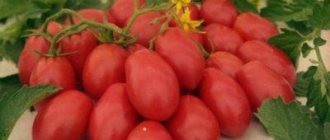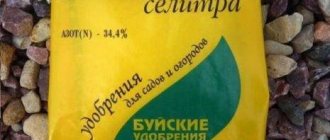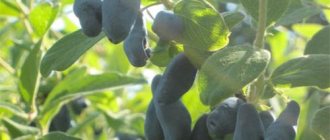Is it possible to fall in love with tomatoes? If this is an Early Love tomato, then absolutely. This variety is the embodiment of excellent properties, a lot of beneficial advantages, and easy cultivation. Appeared in the late 90s, entered the register in 2001.
| Height | Landing location | Ripening time | Fruit color | Fruit size | Origin | Fruit shape |
| Tall | Greenhouse, Open ground | Early ripening | Reds | Average | Variety | Flat-round |
Characteristics and description of the tomato variety Early Love
The Early Love tomato variety is early ripening, the crop is grown to obtain an early harvest. The first fruits can be harvested 90-100 days after germination. In the southern regions, bushes are most often planted in open ground; in the middle zone, in the Urals and Siberia, it is recommended to grow the Early Love tomato in greenhouses.
The bushes are tall, in protected soil they grow up to 2 m, in outdoor beds - about 180 cm. It is recommended to tie the stems to vertical supports.
The leaves are the usual tomato shape, medium in size, dark green in color. The first ovary is formed above the 6-7th leaf. The inflorescences are presented in racemes, each with 4-5 flowers. Almost all of them set fruit.
The fruits are round in shape. At first they are green, but at technical ripeness they are bright red. Tomatoes have a dense, glossy surface. The ribs are clearly visible in the area of the stalk.
The weight of the fruit varies between 85-100 g. Those tomatoes that are on the lower tassels sometimes have a weight of 200 g. The attachment of the fruit is strong, they do not break off even after full ripening. Fruiting is long-lasting; you can see red and green tomatoes on one bush.
The tomatoes are fleshy and dense. There are only 3-4 seed chambers, few seeds. This feature is highly valued by summer residents, since the fruits do not crack when transported over long distances.
Features of cultivation and storage
The seedlings are transplanted into beds at the age of 50-60 days.
Cultivation is carried out in open areas and in greenhouse conditions. To achieve good harvests:
- 3 bushes are placed per 1 m2;
- formation is carried out in 2-3 stems;
- stepchildren are born once every 12 days;
- Root and foliar fertilizers are used.
Fertilizing the beds must be carried out during flowering, as well as at the stage of setting and ripening.
Among the nutritional components used:
- yeast;
- bioinfusions;
- 1:10 diluted solution of mullein or dung;
- infusion of eggshells;
- phosphorus-potassium mixture;
- potassium sulfate;
- nitrogen fertilizers.
Taste qualities of tomatoes Early love
The taste of the fruits of the Early Love variety is sweetish, the acid is almost not felt. Tomato is rich in vitamins and beneficial elements. The smell of the fruit is truly tomato.
Sweet tomatoes can be preserved whole in barrels and used to prepare various preparations for the winter. In particular, tomatoes of the Early Love variety produce delicious tomato juice with pulp.
Early fruits are an excellent addition to the diet, because few people will refuse a delicious salad made from fresh tomatoes.
Important! When heat treated, the fruits of the Early Love variety retain their taste and beneficial properties.
Tomato Love F1: a good hybrid for any purpose
Tomato Lyubov F1 is one of many representatives of modern hybrids that is not difficult to grow. The plant is easy to care for, and the tasty and beautiful fruits will satisfy the needs of the most demanding gardener. This hybrid is accompanied mainly by only positive reviews from gardeners.
Description of the tomato variety Lyubov
Tomato Love is the development of Yuri Ivanovich Pantchev, who mainly deals with tomatoes and peppers. The hybrid was registered in the State Register of Breeding Achievements of the Russian Federation in 2006 and is intended for planting in any region. It is recommended for personal subsidiary plots and other small-scale farms; it is grown both in unprotected soil and under film covers: depending on the climate of the region, one or the other option is more suitable.
The Lyubov tomato is a determinate variety, but the bush, especially in a greenhouse, can grow quite tall - more than a meter. Therefore, plant formation and stem tying are necessary procedures.
The leaves are green and of normal size. The first flower cluster is formed after the seventh or eighth leaf, the next ones after one or two. 5-6 tomatoes are formed in the brush.
In terms of harvest ripening, the tomato is mid-season. The tomatoes are medium-sized, weighing 50–75 g, regular round in shape, with barely noticeable ribbing. No cracking is observed. When ripe, they are colored red and contain 4 or more seed nests. The taste is rated excellent. The main use is for salads, but the shape and size of the tomatoes allow them to be preserved as a whole.
Hybrid tomatoes Lyubov F1 - regular round shape
The yield of the hybrid is average, just over 5 kg/m2. It has increased resistance to diseases, especially resistant to verticillium and fusarium. No cracking of the fruits was observed even in damp weather or when left on the bushes.
Features of the Lyubov F1 hybrid from different manufacturers
Seeds of the hybrid Lyubov F1 are produced by different companies. The data indicated on the bags may differ slightly from that provided in the State Register of Breeding Achievements of the Russian Federation. For example, it claims that the hybrid is early ripening and the first fruits ripen within 100 days after sowing, and weigh 200–250 g, although most of the information on the packaging is true. in a similar situation, he reports that the yield of the hybrid is four (!) times higher than that declared by the author and stated in the official document. Therefore, the video below should be treated with skepticism.
Video: advertising of tomato seeds Lyubov F1, which does not correspond to the information in the State Register of Breeding Achievements of the Russian Federation
Advantages and disadvantages
There are quite a lot of varieties and hybrids of tomatoes similar to the one under consideration; it is nothing outstanding, but, like any modern hybrid, it has many more advantages than disadvantages.
The fruits of the Love tomato are ordinary small red balls
The advantages of the Love tomato are:
- excellent presentation of the fruit;
- evenness of tomatoes, i.e. all tomatoes are approximately the same size;
- good transportability;
- no cracking under any conditions;
- good drought resistance;
- increased resistance to diseases;
- excellent taste, not always typical for tomatoes of this shape and size;
- versatility of application.
Among the disadvantages of the hybrid, they note the not very good yield, which strongly depends on the fertility of the soil, as well as the need for the formation and staking of bushes, which can be dispensed with for many determinate varieties.
Differences from other varieties
When considering the Love tomato, you need to be very careful and critical of the information provided on the Internet. And this is not only a matter of malicious intent, but often also of carelessness: there are several varieties of tomatoes with similar names:
- Earthly love by the same author, bearing fruit with tomatoes weighing at least 200 g;
- Lyubushka: this variety has a high yield, but the taste of fresh fruit is rated only as good;
- hybrid My Love by breeder L.A. Myazina, which has nothing to do with the tomato in question;
- Novosibirsk variety Early Love, most of the indicators of which, with the exception of the ripening period, are similar to those of the Lyubov tomato.
Photo gallery: tomato varieties with names similar to Lyubov
Features of planting and growing the Lyubov tomato
Agricultural technology of the Lyubov tomato has no obvious characteristics; it is grown similarly to many other determinate varieties of medium ripening. Sowing seeds directly into a garden bed is possible only in the southernmost regions, but even there, with this technology, it will be possible to get fruits only in the second half of summer. Therefore, usually the seedling stage is not neglected; seeds are sown in boxes at the usual time - around mid-March or a little later. For greenhouse cultivation, seeds are sown at the very beginning of spring.
Caring for seedlings is usual: you must not miss the moment of the appearance of the very first shoots in order to move the box to a well-lit, cool place and keep it there for up to a week. Subsequently, the seedlings are kept at room temperature, and picking is carried out at the stage of two true leaves. The humidity regime is normal, it is advisable to do without fertilizing.
Tomato seedlings Lyubov grow normally, and the bushes are of average size before planting in the garden
Seedlings are planted in a garden bed with the onset of warm weather: in the middle zone at the very beginning of summer (in a greenhouse - depending on its quality). The planting density is average, the optimal pattern is 40x70 cm. Plant care is standard. The soil is often loosened or kept under a good layer of mulch.
Despite the fact that this hybrid is not subject to cracking of the fruits, as they begin to ripen, watering is significantly reduced so that the tomatoes gain sugar: the Lyubov tomato is not afraid of drought, but many experienced gardeners note excessive sourness in the taste of the fruit.
It is reported that three standard fertilizers are not enough for this tomato: after fruit set, the plants are fed every two weeks, mainly using mullein infusions with the addition of wood ash. The hybrid's resistance to disease is high, but in those regions where late blight is often observed, preventive treatments with copper-containing preparations are necessary.
Most often, this tomato is grown in two stems: a strong stepson located under the first flower cluster is chosen as the second. The remaining stepsons, as they appear and reach a length of 4–5 cm, are systematically broken out. At first, the bush does not need to be tied up, but as soon as the tomatoes begin to gain weight, tying up the stems in several places is necessary. There is no need to tie the brushes separately: they are not so heavy as to break the shoots.
Tomato bushes Lyubov grow according to one of the traditional patterns, usually in two stems
Reviews of the hybrid Love
Due to the ambiguity of the name, it turns out that the number of reviews specifically about the Lyubov F1 hybrid is very small.
I would like to share my impression of one of my favorite tomatoes - the hybrid Lyubov F1. The fact that the tomato is determinate is a big plus for me, since a tomato tree will not grow. When growing it, I don’t bother it at all; it grows as it wants. Of course, I feed it, spray it with a solution of boric acid (1 g per 1 l) during flowering, tie it up, and pick off unnecessary leaves. Moderate watering at the root. Phytophthora does not occur in a greenhouse. The hybrid is declared as early, but this year it began to turn brown at the end of July.
Novikova Maria, Smolensk region
Pros and cons of the Early Love tomato variety
First you need to understand the positive properties of the Early Love tomato. These include:
- Early ripening, unpretentiousness of the plant, resistance to adverse conditions. Short-term drought does not affect yields.
- Resistance of fruits to shedding and cracking.
- Versatile culinary use.
- Good ripening of unripe tomatoes in a dark room.
- Excellent keeping quality and transportability.
- High taste qualities.
- Excellent resistance to diseases and crop pests.
- Possibility of growing in any region of the Russian Federation, in open or protected ground, depending on climatic conditions.
The Early Love variety has many advantages, but one should not keep silent about the disadvantages:
- relatively low yield;
- the need for fertilizing during the growing season;
- weak branches that need to be tied up.
Caring for the variety after transplantation
This variety can be successfully grown even by novice gardeners, since it is not too demanding to care for. In open ground, it does not need to be pinched, that is, remove excess leaves and shoots. If you do this, the tomato will bear fruit much later.
This hybrid has practically no extra stems, except for the first two shoots. If you remove them, the fruits will be larger, but the overall yield of the bush will decrease.
During the entire growing season, tomato love responds well to potassium and phosphorus fertilizers. A feature of the variety is tolerance to minimal amounts of moisture, as well as good tolerance of different temperatures and lack of lighting.
The big advantage is that the hybrid actively bears fruit before the onset of frost.
Growing
To obtain an early harvest, Early Love tomatoes are grown through seedlings. Seeds should be sown 60 days before planting in open ground. So the timing is different in each region, since they depend on climatic conditions.
Growing seedlings
Before sowing seeds, prepare fertile soil, containers and seeds for seedlings. The soil and container are doused with boiling water with the addition of potassium permanganate to protect the plants from fungal diseases, in particular blackleg. The seeds are treated with Fitosporin or soaked in a light solution of potassium permanganate.
The seeds are sown in furrows at a distance of 3 cm. The depth of planting the seed is no more than 1.5 cm. After sowing, the soil is irrigated with a spray bottle and the containers are covered with a transparent bag to accelerate seed germination.
Place the container on a bright window in a warm room. When the first shoots appear, the film is removed.
When 2-3 true leaves appear on the Early Love tomato seedlings, it is necessary to pick. Plants are transplanted into separate cups or peat pots. The soil used is the same as when sowing seeds.
When the seedlings take root, they are fed with complex mineral fertilizers or an ash solution. You need to water it carefully at the root with warm, settled water. Cold liquid is not only poorly absorbed, but also retards the growth of seedlings.
Important! Tomatoes of all varieties do not tolerate stagnant water; this must be monitored, otherwise the roots will rot.
Landing rules
If plants are grown in open ground, then planting is planned after the soil warms up to 10-12 degrees to a depth of 15-20 cm and the threat of return frosts disappears. In Siberia it is approximately June 12-15. They are planted in the greenhouse in early May (if it is heated) or in the second half of the month.
The site is prepared in advance, weeds are removed and dug up. If necessary, add organic fertilizers and always wood ash.
Planting of seedlings is carried out after 4-5 days, when the soil settles. The holes are dug to a depth of 25 cm according to the 40x50 cm pattern. For 1 sq. m plant no more than 4 bushes. The seedlings are carefully removed from the container and placed in the center of the hole. Sprinkle with earth and water generously with warm water.
Advice! If the plants are tall, they are immediately tied to a vertical support.
Watering and fertilizing
After planting, the Early Love tomato is watered every day. Then after 5-7 days, if there is no precipitation. Although the variety is resistant to short-term drought, during the formation of ovaries and ripening of fruits, the plantings need to be irrigated every 4 days.
Be sure to pull out the weeds, since it is on them that harmful insects settle. After watering, the soil around the bushes is loosened.
When grown in protected soil, air temperature and humidity are controlled. In a word, they ventilate in a timely manner.
As for fertilizing, they use a complex mineral fertilizer that contains phosphorus and potassium. The Early Love tomato responds well to feeding with an infusion of green grass and wood ash.
Pinching and tying
Since the Early Love tomato is a tall plant, it needs to be constantly tied up. It is best to use vertical supports. The first time the stems are fixed is after planting, then as they grow. In order not to load the plant, the lateral stepsons are removed in the same way as the leaves located below the ovaries.
Formation
Bushes of the Early Love variety are grown in 2-3 stems. They will form a sufficient number of brushes that will not overload the bush. In this case, the plant will have enough moisture and nutrition.
Protection from diseases and pests
The early-ripening variety produces the main harvest before the time when late blight begins to dominate the gardens, so the bushes are practically not affected by this fungus. They also rarely get sick:
- fusarium;
- verticillium;
- VTM.
But Phoma cannot always be avoided. The drug “Hom” is used for treatment. Fruits with signs of disease are destroyed.
If we talk about pests, plantings of the Early Love variety may suffer from:
- codling moths;
- sawyer;
- hare;
- Colorado potato beetle.
Special preparations are used to destroy them.
You can avoid diseases and pests in beds with tomatoes. Early love is possible if you follow agricultural care techniques.
How to grow seedlings
Experienced gardeners recommend planting the Early Love tomato in seedlings. This makes it easier for vegetables to take root in the soil and get used to a certain climate. Seedlings are prepared 55-60 days before planting in the ground. You will need soil, a container, seeds, as well as a disinfectant solution and growth stimulants.
Seed preparation
Before planting, the seeds are disinfected and germinated. To disinfect, place them in a cloth bag and soak them in a hydrogen peroxide solution. It will destroy all germs and dangerous bacteria on the surface of the seed. Germination involves placing the treated seeds in slightly damp gauze and placing them in a plate with a small amount of water.
Germination helps the first shoots sprout faster and develop immunity against possible diseases. In addition, this is how gardeners check the quality of the material and the percentage of overall germination. For the most powerful effect, add growth stimulants to the water: the most common of them are “Zircon”, “Silk”, “Epin-extra”.
Important! Aloe juice serves as an organic supplement. The seeds are dipped in juice in a fabric bag and then dried to a loose state. Aloe juice increases the overall germination of seeds by up to 25%.
Container and soil
The soil for seedlings must be nutritious and contain the vitamins necessary for the plant. It is recommended to purchase ready-made soil for seedlings in the store, since the manufacturer will comply with all norms and requirements. But some go the other way and prepare the ground on their own.
For this use:
- soil from the garden;
- humus;
- sawdust;
- peat.
These elements are mixed in a ratio of 4:1:1:1 and placed in the freezer for a day. The cold will kill larvae and pathogens.
After hardening, the soil is taken out and poured into containers for seedlings: plastic cassettes, peat pots, flower pots. All this is sold in gardening stores.
However, to avoid unnecessary expenses, many gardeners use ordinary plastic jars of sour cream or mayonnaise for seedlings. The main thing is to wash them thoroughly, dry them and make small holes at the bottom through which excess water will flow out when watering.
Sowing
Add soil to the container and make small grooves. The ideal distance between them is about 3 cm. Sprouted seeds are placed in the holes, covered with soil on top and thoroughly watered with settled warm water.
It is recommended to cover the top of the seedlings with plastic film or a lid, which is removed only after the first shoots appear.
Growing and care
Place the seedlings in the warmest and brightest place in the house.
If this is a windowsill, then be careful not to allow drafts. Plants should receive at least 15 hours of sunlight per day. If there is less daylight in your region, arrange additional lighting using lamps. The first watering is carried out on the 10th day after planting. Never water the sprouts with cold tap water. Also try to ensure that the water gets mainly under the root, and not on the leaves and stem. To do this, use a pipette or syringe.
The Early Love variety loves feeding, so organize the first one after 15 days. A solution based on onion peels or wood ash is excellent for this. In the future, fertilizing is carried out regularly before planting the seedlings in the ground.
Characteristics of growing tomato love f1
Tomato love f1 is one of the most famous varieties. Tomatoes have the following parameters: excellent taste, high yield, ripening up to 90 days. Even beginners in gardening can grow this variety. Tomato love is not capricious in care. The variety is resistant to diseases.
Description of tomato
Tomato love f1 has bushes up to 1.3 meters. Ninety days pass from planting to the appearance of ripened fruits. It is a mixed species for cultivation in open ground, as well as in a greenhouse. It is highly resistant to cracking. The plant is resistant to diseases and insect attacks.
With excellent care, you can collect no more than 6 kg from one bush. Thanks to proper planting, you can achieve a yield of 20 kg per m2.
A ripe tomato is scarlet or dark crimson in color, rounded in shape, distinguished by a smooth surface, without folds, and a green spot near the stalk. The pulp of tomatoes is quite sugary, but with sourness. One brush includes 5 or 6 large tomatoes. Tomato weight up to 230 grams. The fruits are the same. The advantages of the variety include:
- frost resistance;
- high productivity;
- excellent taste;
- low light resistance;
- tolerance to drought and heat;
- tie perfectly regardless of atmospheric circumstances;
- resistance to stress.
Among the minuses recorded:
- strong support required;
- need for constant feeding;
- Frequent curling and falling of leaves.
Differences from other types
When considering tomato love, you need to pay attention to information on the Internet. There are several varieties of tomatoes that are similar in name:
- "Earthly love." Weight not less than 200 grams;
- "Lover". Tomatoes are also high yielding;
- “My Love” by breeder Myazina has nothing to do with the variety;
- Tomato variety “Early Love” is similar to the Love variety. But their ripening period is different.
Early love variety
Tomato bushes have a height of up to two meters. The first fruits appear ninety days after germination. Inflorescences in racemes, with six ovaries in each. The fruits are spherical in shape and have slight ribbing at the stalk. The skin is strong. When fully ripe, it acquires a bright red or purple color.
On average, a tomato of the Early Love variety weighs 90 grams. The bush produces about two kilograms of ripe fruits. Due to the fact that the fruits have a strong peel, they are easy to store. Can be stored for a couple of weeks. Suitable for transportation over long distances. The fruits do not crack; there are four seed chambers in the cross section.
Cons of tomato early love:
- fruiting at a low level;
- the structure of the branches is weak;
- At the formation stage, tomatoes are capricious about the application of fertilizers.
Sort of earthly love
Earthly love tomatoes are classified as early ripening species. Ripening period is up to 105 days. Tomato bushes are tall. In the garden they grow up to 130 cm, and in the greenhouse up to 150 cm. They have a strong, thick stem. The fruits are red in color and take on a flat, rounded shape with pronounced ribbing. Almost identical fruits grow on one bush. On average, one tomato weighs 230 grams. The pulp of this species is juicy and sweet.
Disadvantages include pinching and gartering and fragility of the stalk.
Planting and ripening of the love variety
The love tomato variety is a mid-early hybrid. Fruiting begins after three months. This is from 105 to 110 days after landing. Sowing is done at the end of March, and seedlings are planted in May. Let's look at how to plant love tomatoes.
Dense planting of bushes is not recommended. When preparing holes, it is necessary to maintain a step of 40 cm in a row between 2 bushes and 70 cm between two rows. Fertilizers are added to the holes, including phosphorus, nitrogen, and potassium.
When the soil is very compacted, you need to add additives to lighten its structure. To do this, add peat and sand. When the acidity level is high, it should not be lowered. Because tomatoes grow well in acidic soil.
Tomato care love
Plants need to be watered every 5 days. The water needs to be defended. It is necessary to monitor the soil moisture. It is better to reschedule watering when the soil has not absorbed water since the last time. You need to water tomatoes in the evening, when the sun has set.
Loosening and weeding are carried out as needed. Most often, operations are performed once every 10 days. It is recommended to remove stepchildren from bushes during the growing season. To avoid damage to the branches, use strong supports. Feeding is carried out up to four times per season. For the normal formation of bushes, it is necessary to use combined mixtures, including potassium and phosphorus, and nitrogen fertilizers.
Recommendations for cultivation
The timing of sowing must be determined taking into account the planting location and climate in the area where your site is located. Cultivation begins with the preparation of seeds for sowing. It is recommended to sort and disinfect self-made seeds. They must be sown to a depth of 2 cm. Then the container with the seeds must be covered with film and taken to a place where the temperature is 25 C. In March, it is advisable to illuminate with fluorescent lamps so that the total daylight hours are approximately 14-16 hours. Incandescent lamps are prohibited.
In the phase of 2 true leaves, it is recommended to plant seedlings in cassettes or glasses. The need for seedlings to fertilize depends on the soil and partly on the temperature in the greenhouse. Extracts from humus and Fertik are suitable fertilizers. Before planting, hardening at 14 C is recommended.
Before planting, it is recommended to add a bucket of compost, a glass of ash and 25 grams of superphosphate per 1 m2. Up to 5 plants are planted per meter.
Tomato diseases love
The variety is resistant to a number of diseases, but it is worth carrying out prevention. Ventilate the greenhouse from time to time to reduce the possibility of fungal diseases. A balanced solar and watering regime is recommended. In case of illness, it is necessary to use the drug "Hom".
Don't forget to remove the affected fruits. It is worth fighting the Colorado potato beetle. Use chemicals (for example, "Prestige"). Sometimes the plant is affected by black spot (a disease caused by the aerobic, gram-negative bacterium Xanthomonas campestris).
On the outer side of the leaf, grayish-brown, rounded spots appear over time, darkening over time, from 5-6 to 14-16 mm in diameter. “Fitolavin” will help against illness. To prevent the appearance of rottenness, they are treated with calcium nitrate. At the same time, it is worth reducing the amount of watering.
Collection and saving
The fruits are harvested immediately after ripeness. The delay threatens rapid spoilage of the vegetable. You can remove green fruits from the bushes. Ripening takes place within a month. There is no need to be afraid of picking off ripe tomatoes: they are easily transported without damaging the shells.
Store vegetables at temperatures from +14 to +16 C in a well-ventilated area. Free air flows prevent fruit spoilage. It is necessary to regularly re-sort vegetables so that rottenness does not pass from tomato to tomato. Good fruit safety is guaranteed by freezing. The only disadvantage of this method is the change in taste.
Reviews
Inna: “For several years in a row I have been giving preference directly to the Lyubov variety tomatoes. And I can’t get enough of my own harvest. One bush produces up to 6 fruits. The taste is rich and sweet. Diseases must be fought with pharmaceuticals or folk recipes. Therefore, I can recommend it as one of the best varieties of tomatoes.”
Elena: “I have been looking for the best varieties of tomato for a long time. The love variety was recommended by a neighbor. Fruit ripening is surprisingly fast. I collect up to 6 kg from a bush. To prevent various diseases, after moving the bushes to a permanent place, they are treated with the substance “Fitosporin”. If symptoms of the disease occur, the infected bushes must be eliminated by throwing them outside the garden. The fruits are very tasty and last a very long time. Before this, my family mainly preferred Cherry, but these tomatoes replaced them. And it’s not so difficult to grow them, water them more, tie them up. You can plant, but the harvest will be smaller. But the tomatoes themselves will be large in size. I recommend it to gardeners and even beginners in growing crops.”











